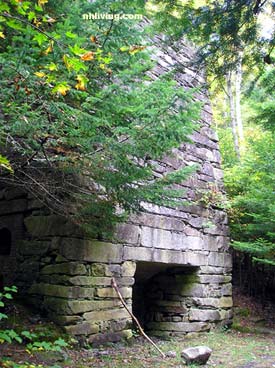Something On The Trail
Limestone Kilns Add Unusual Sight To Your New Hampshire Hike
 Used throughout history to create quicklime, limestone kilns date back to 13th Century agricultural societies, if not earlier. Limestone kilns are found through out the world, from Great Britain and Belgium to Australia and America. Ask us about NH Lime Stone Kiln hikes or share comments. To feature your business, contact us.
Used throughout history to create quicklime, limestone kilns date back to 13th Century agricultural societies, if not earlier. Limestone kilns are found through out the world, from Great Britain and Belgium to Australia and America. Ask us about NH Lime Stone Kiln hikes or share comments. To feature your business, contact us.
New Hampshire Limestone Kilns
 Hiking along a trail on Black Mountain in Pike, NH could produce an unusual sight that one might not expect to see. Stone structures that look like a novice approach to an outdoor B-B-Q stick out of the ground covered with moss and fallen tree branches. These marvelous structures are the well preserved remains of lime kilns built in the 1800’s.
Hiking along a trail on Black Mountain in Pike, NH could produce an unusual sight that one might not expect to see. Stone structures that look like a novice approach to an outdoor B-B-Q stick out of the ground covered with moss and fallen tree branches. These marvelous structures are the well preserved remains of lime kilns built in the 1800’s.
In 1837, limestone was discovered at the base of Sugar Loaf Mountain in the White Mountains of New Hampshire. Chester Spooner soon built the first kilns to burn limestone. Soon after, a large amount of limestone was found on Black Mountain in Pike, NH. In 1842, William Gannett built a second kiln which was financed by John Page, Governor of New Hampshire.
The road known today as Lime Kiln Road was used to haul lime off the mountain by oxen and horses. Lime was hauled to the Connecticut River to be shipped by boat. Once the railroad was opened, lime was brought to the East Haverhill Station to be shipped.
The lime kilns were operating until 1888. Until that time, the kilns produced 300,000 casks per year of lime. The operation of the lime kilns had brought in many workers and their families to the surrounding area.
The oldest of the kilns sit firmly at the bottom of the trail. These particular kilns were smaller in size, yet had many ovens in a row. The most impressive of the kilns is the one that stands alone at the top of the trail. This kiln stands approximately 20 feet high. In the 1930’s the magnificent kilns were restored by unemployed transients who were led by a skilled stone mason.
Today the kilns still stand proud of the work accomplished in the 1800’s. The kilns are maintained by the Heritage Committee of the Town of Haverhill.
Getting There:
From the South: I-91 North to Exit 16 Bradford, VT exit. Turn right off the exit ramp to the red light. Turn left onto US Route 5 North. Turn right at Newbury Crossing, crossing into New Hampshire. At the stop sign turn right onto NH Route 10 South. Turn left onto Mt Moosilauke Hwy/NH-25. Turn left onto Lime Kiln Road. Follow Lime Kiln Road for 3.1 miles. The trail head is on the right with a large turn around.
Follow the trail until reaching a logging road. Turn left onto the logging road, walk for about 20 yards. On the right is a sign that will read “Kilns”. Follow the trail until you see the first row of kilns on the left. It is a series of 3 kilns about 8 feet in height. Follow the trail past the first set of kilns and up the hill to find the second and largest of the kilns.
inns | hotels | resorts | rentals | attractions | dining | real estate
NH Lodging Guide | Weddings
Products | NH Town Guides
New England Living | Hiking
Free World Mall
Country Weddings | New England Recipes
Paradise Coast Living | Boston Red Sox Gifts
Vermont Living | ME Living | MA Living







